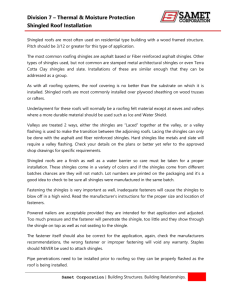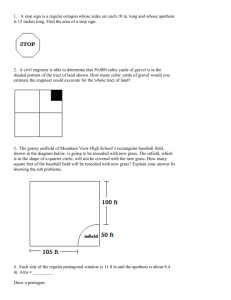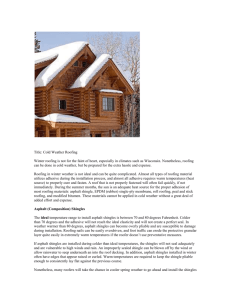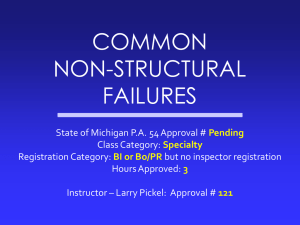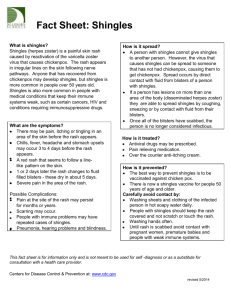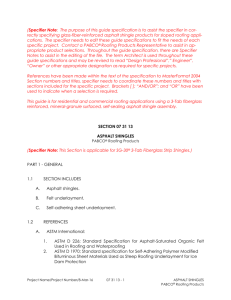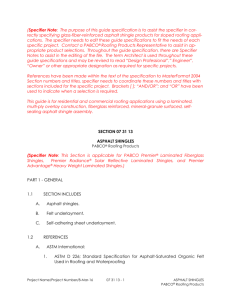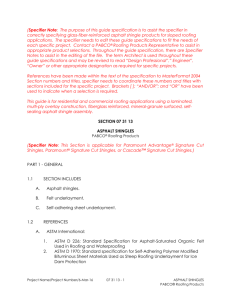UF Research Attachment - Florida Building Code
advertisement
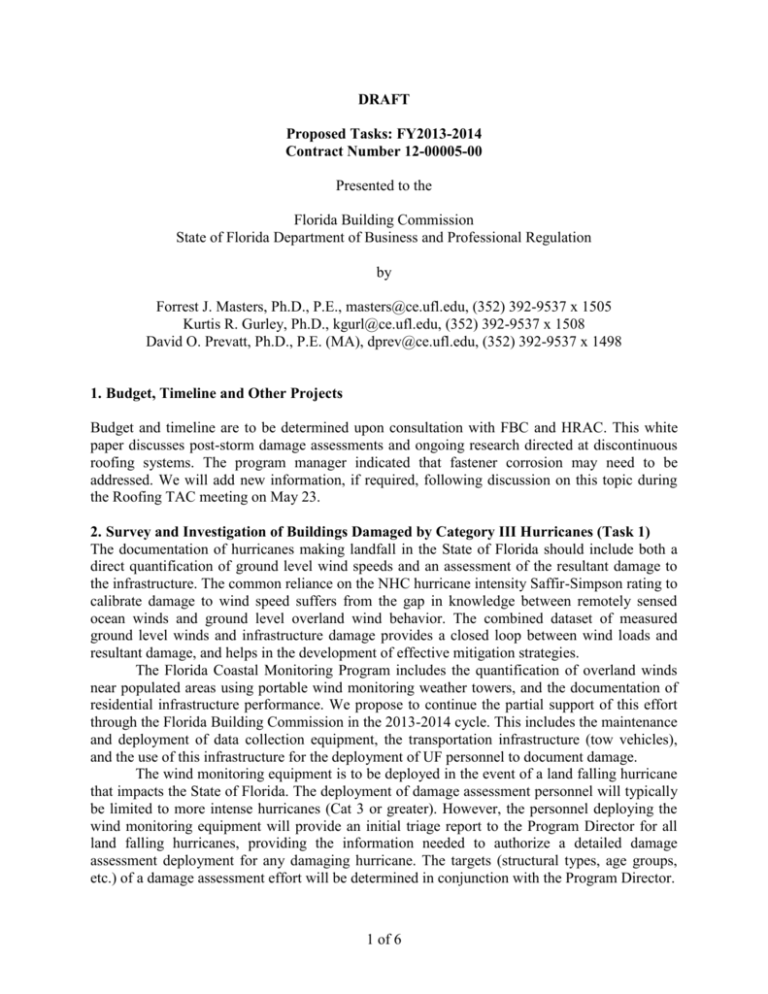
DRAFT Proposed Tasks: FY2013-2014 Contract Number 12-00005-00 Presented to the Florida Building Commission State of Florida Department of Business and Professional Regulation by Forrest J. Masters, Ph.D., P.E., masters@ce.ufl.edu, (352) 392-9537 x 1505 Kurtis R. Gurley, Ph.D., kgurl@ce.ufl.edu, (352) 392-9537 x 1508 David O. Prevatt, Ph.D., P.E. (MA), dprev@ce.ufl.edu, (352) 392-9537 x 1498 1. Budget, Timeline and Other Projects Budget and timeline are to be determined upon consultation with FBC and HRAC. This white paper discusses post-storm damage assessments and ongoing research directed at discontinuous roofing systems. The program manager indicated that fastener corrosion may need to be addressed. We will add new information, if required, following discussion on this topic during the Roofing TAC meeting on May 23. 2. Survey and Investigation of Buildings Damaged by Category III Hurricanes (Task 1) The documentation of hurricanes making landfall in the State of Florida should include both a direct quantification of ground level wind speeds and an assessment of the resultant damage to the infrastructure. The common reliance on the NHC hurricane intensity Saffir-Simpson rating to calibrate damage to wind speed suffers from the gap in knowledge between remotely sensed ocean winds and ground level overland wind behavior. The combined dataset of measured ground level winds and infrastructure damage provides a closed loop between wind loads and resultant damage, and helps in the development of effective mitigation strategies. The Florida Coastal Monitoring Program includes the quantification of overland winds near populated areas using portable wind monitoring weather towers, and the documentation of residential infrastructure performance. We propose to continue the partial support of this effort through the Florida Building Commission in the 2013-2014 cycle. This includes the maintenance and deployment of data collection equipment, the transportation infrastructure (tow vehicles), and the use of this infrastructure for the deployment of UF personnel to document damage. The wind monitoring equipment is to be deployed in the event of a land falling hurricane that impacts the State of Florida. The deployment of damage assessment personnel will typically be limited to more intense hurricanes (Cat 3 or greater). However, the personnel deploying the wind monitoring equipment will provide an initial triage report to the Program Director for all land falling hurricanes, providing the information needed to authorize a detailed damage assessment deployment for any damaging hurricane. The targets (structural types, age groups, etc.) of a damage assessment effort will be determined in conjunction with the Program Director. 1 of 6 The tasks will include: Maintain data collection and transport equipment as necessary for measuring intensity of land-falling hurricanes and documenting damage Perform field data collection preparation to include: training of personnel on data collection protocols and tools; purchase and organize data collection and recording equipment including cameras, documenting equipment and software for database construction; and other essential items approved by the Department project manager Deploy wind monitoring assets in the event of a land-falling hurricane Provide an initial triage assessment of damage to the residential infrastructure Organize a formal damage assessment effort should the Program Manager determine it is warranted 3. Wind Load Resistance of Asphalt Shingle Roof Systems (Task 2) 3.1. Motivation Recent studies led by the investigators have shown that significant shingle loss in high winds is prominent for roofs that have naturally aged ~ 6 years or more, but not as prominent for newer roofs. UF researchers are currently finalizing technical papers of recent studies that experimentally identified: 1. A strong correlation between shingle vulnerability to wind and the pre-wind event condition of the sealant that attaches the underside of the leading edge of the shingle to the top of the course of shingles below it. 2. A large percentage of the existing aged roof inventory (also ~6 years or more) have widespread occurrences of numerous unsealed shingles. The observed cohesive failure of the sealant indicates that these shingles were initially sealed upon installation, and became unsealed as a result of natural aging. Together these findings strongly indicate that a major contributor to the failure of shingles in high winds is the loss of adhesion in the sealant over time, unrelated to a wind event. It has been clearly demonstrated that this loss of adhesion occurs in a much shorter time frame than the recommended 20 year replacement cycle of asphalt roofs. This disconnect between the actual and expected performance of asphalt shingles may be readily solvable. 3.2. Proposed Research The necessary component to seek a solution is the identification of the mechanisms that lead to the unsealed condition. A recently completed field study to identify unsealed shingles on 27 homes in Florida lead to the observation that the pattern of in situ unsealed shingles systematically coincide with the installation pattern. For three-tab shingles, the unsealed shingles were observed on the extreme end tab of the strip where the end joint of the shingle course (row) below aligned with the centerline of the tab (Figure 1a). Laminate shingles exhibited a similar pattern of unsealing with the unsealed length running from the end joint of the strip to the end joint of the shingle course below (Figure 1b). As shown in Figure 2, this produces unsealed shingle patterns corresponding to their installation method: vertically aligned for vertical 2 of 6 installations and diagonally aligned for diagonal installations, with the unsealed line located at the end joint of the course beneath. We hypothesize that the likely causation of age related shingle unsealing is thermal cycling producing unevenly distributed stress concentrations in the sealant due to the shingle installation pattern. The hypothesis will be investigated in a one-year performance period beginning July 1, 2013. The methodologies will include experimental and finite element analysis (FEA) investigations of the stress concentrations in the sealant when the shingles are subjected to time varying thermal loads. A consistent finding of higher stress / strain at the sealant on the tab that overlaps the end joint of the course below will confirm the causation hypothesis. The experimental work will be conducted using existing laboratory facilities, primarily the accelerated aging chamber that allows a controlled time varying heat, UV, and water spray environment. Relative displacements between shingle courses and stresses at the adhesive interface will be monitored to identify regions of higher stress / strain concentrations. The FEA computational component will utilize existing software currently licensed to UF. The benefit of the FEA component will be to provide initial guidance regarding the feasibility of the hypothesis, and to help tailor the specific conditions to be used in the experimental work. If experimental and FEA results are closely aligned, the FEA will provide the means to investigate numerous alternative adhesive options either at initial installation or as a retrofit for unsealed shingles. Those adhesive options that provide the best remedy in a FEA modeling framework may then be tested in the physical experimental facility. This process can optimize the available time and financial resources by avoiding physical testing of options that are shown to be unviable through the FEA modeling. (a) (b) Figure 1. Location of unsealed tabs for (a) three-tab and (b) laminate shingle systems. 3 of 6 Figure 2. Blue tape denotes the location of partially/fully unsealed three-tab and laminate shingles. The pattern corresponds to the installation method. 4. Tile Roof Systems 4.1. Motivation The goal of this project is to expand the knowledge base on the performance of hip and ridge attachments in strong winds. Four research components are currently underway. Generalized descriptions follow. Please consult the Experimental Research Plans provided earlier for a detailed description of these activities. a. Characterization of Wind Induced Pressures on Field Tiles. The Contractor is measuring the pressure distribution on the top and bottom of field roof tiles for multiple wind speed and direction cases. Models of low-, medium- and high-profile roofing tiles were generated using rapid prototyping. Each model has approximately 256 ports on the surface that are connected a pressure scanning system (PSS). The tiles (both on a bare deck and in a field of real tiles) are subjected to a wind field in UF’s newly constructed Dynamic Flow Simulator, which was designed to simulate near roof surface flows (Figure 3). Geometric information is used to resolve reaction forces at the attachments. 4 of 6 (a) View of the test chamber in the DFS. (b) View of the pressure scanning system and the tile model on the turntable Figure 3. Measurement of pressure distributions on full-scale roofing tile models b. Quantification of Wind-Induced Reaction Forces on Field Tiles. Real tiles (identical to the former subjects) are instrumented with six-axis load cells that measure uplift forces and moments. Tile decks are placed in the DFS and subjected to a high-speed surface flow. The resultant measurements are compared directly to the results of Component 1. c. Mechanical Uplift Resistance of Roofing Tile Attachments. The Contractor devised an efficient system to apply the shear (uplift) and moment (prying) to tile sections (Figure 4). Results from (a) have shown that the aerodynamic center is located at the ¾ chord point, which is the stipulated distance in the current testing practice. Thus, we are currently developing interaction diagrams (i.e., uplift vs. prying) that should be applicable to a wide range of incident wind angles. Figure 4. Mechanical uplift apparatus. Roofing tile ‘columns’ are loaded on a rack that slides through a universal testing machine. The configuration allows for rapid testing (~50 tests per day). The point load can be applied at any location on the roofing tile. d. Characterization of Mechanical Uplift Resistance of Hip and Ridge Attachments. The Contractor is coordinating with Florida International University on Component 4. Testing in the Wall of Wind full scale wind test facility is currently planned for the week of June 10. 4.2. Remaining Work Remaining goals for this project include: 5 of 6 Synthesis of results from (a) – (d) Comparison of experimental results to the values predicted by the “Redlands” method, which is the basis for the Code and its testing application standard for wind resistance Distributing preliminary analysis to industrial oversight committee members for vetting and discussion Comparison of the “Redlands” approach to the ASTM D7158 method to determine wind resistance for asphalt shingle seals. Ultimately this work may lead to a unified approach for determining wind loads for discontinuous roof systems System-level analysis of roofing systems, with consideration of near surface wind flow of over the entire building The principal graduate student on this project is on track to complete his doctoral research by summer 2013. We anticipate producing a final recommendation at this time. 6 of 6
